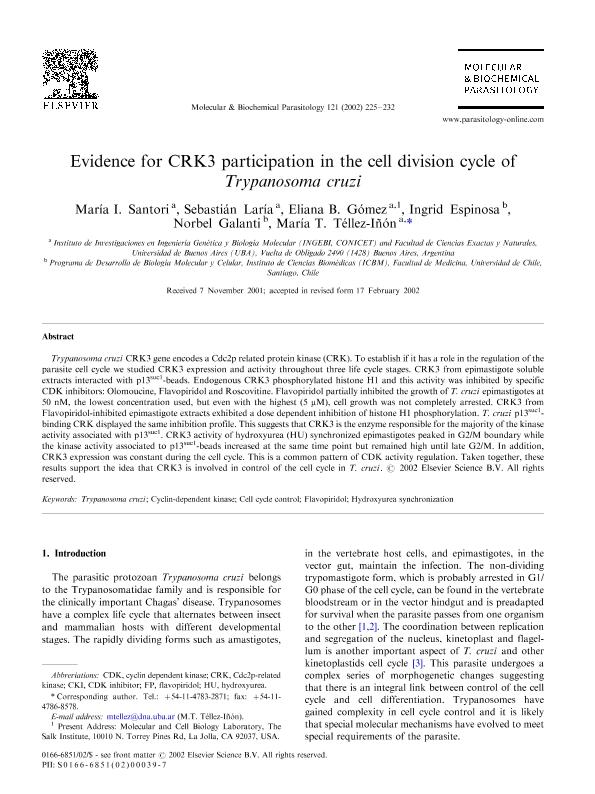Mostrar el registro sencillo del ítem
dc.contributor.author
Santori, Maria I.

dc.contributor.author
Laría, Sebastián

dc.contributor.author
Gomez, Eliana B.

dc.contributor.author
Espinosa, Ingrid
dc.contributor.author
Galanti, Norbel
dc.contributor.author
Tellez, Maria Teresa

dc.date.available
2019-07-17T18:11:53Z
dc.date.issued
2002-12
dc.identifier.citation
Santori, Maria I.; Laría, Sebastián; Gomez, Eliana B.; Espinosa, Ingrid; Galanti, Norbel; et al.; Evidence for CRK3 participation in the cell division cycle of Trypanosoma cruzi; Elsevier Science; Molecular and Biochemical Parasitology; 121; 2; 12-2002; 225-232
dc.identifier.issn
0166-6851
dc.identifier.uri
http://hdl.handle.net/11336/79754
dc.description.abstract
Trypanosoma cruzi CRK3 gene encodes a Cdc2p related protein kinase (CRK). To establish if it has a role in the regulation of the parasite cell cycle we studied CRK3 expression and activity throughout three life cycle stages. CRK3 from epimastigote soluble extracts interacted with p13suc1-beads. Endogenous CRK3 phosphorylated histone H1 and this activity was inhibited by specific CDK inhibitors: Olomoucine, Flavopiridol and Roscovitine. Flavopiridol partially inhibited the growth of T. cruzi epimastigotes at 50 nM, the lowest concentration used, but even with the highest (5 μM), cell growth was not completely arrested. CRK3 from Flavopiridol-inhibited epimastigote extracts exhibited a dose dependent inhibition of histone H1 phosphorylation. T. cruzi p13suc1-binding CRK displayed the same inhibition profile. This suggests that CRK3 is the enzyme responsible for the majority of the kinase activity associated with p13suc1. CRK3 activity of hydroxyurea (HU) synchronized epimastigotes peaked in G2/M boundary while the kinase activity associated to p13suc1-beads increased at the same time point but remained high until late G2/M. In addition, CRK3 expression was constant during the cell cycle. This is a common pattern of CDK activity regulation. Taken together, these results support the idea that CRK3 is involved in control of the cell cycle in T. cruzi.
dc.format
application/pdf
dc.language.iso
eng
dc.publisher
Elsevier Science

dc.rights
info:eu-repo/semantics/openAccess
dc.rights.uri
https://creativecommons.org/licenses/by-nc-sa/2.5/ar/
dc.subject
Cell Cycle Control
dc.subject
Cyclin-Dependent Kinase
dc.subject
Flavopiridol
dc.subject
Hydroxyurea Synchronization
dc.subject
Trypanosoma Cruzi
dc.subject.classification
Otras Ciencias Biológicas

dc.subject.classification
Ciencias Biológicas

dc.subject.classification
CIENCIAS NATURALES Y EXACTAS

dc.title
Evidence for CRK3 participation in the cell division cycle of Trypanosoma cruzi
dc.type
info:eu-repo/semantics/article
dc.type
info:ar-repo/semantics/artículo
dc.type
info:eu-repo/semantics/publishedVersion
dc.date.updated
2019-07-16T14:13:22Z
dc.journal.volume
121
dc.journal.number
2
dc.journal.pagination
225-232
dc.journal.pais
Países Bajos

dc.journal.ciudad
Amsterdam
dc.description.fil
Fil: Santori, Maria I.. Consejo Nacional de Investigaciones Científicas y Técnicas. Instituto de Investigaciones en Ingeniería Genética y Biología Molecular "Dr. Héctor N. Torres"; Argentina
dc.description.fil
Fil: Laría, Sebastián. Consejo Nacional de Investigaciones Científicas y Técnicas. Instituto de Investigaciones en Ingeniería Genética y Biología Molecular "Dr. Héctor N. Torres"; Argentina
dc.description.fil
Fil: Gomez, Eliana B.. Consejo Nacional de Investigaciones Científicas y Técnicas. Instituto de Investigaciones en Ingeniería Genética y Biología Molecular "Dr. Héctor N. Torres"; Argentina
dc.description.fil
Fil: Espinosa, Ingrid. Universidad de Chile; Chile
dc.description.fil
Fil: Galanti, Norbel. Universidad de Chile; Chile
dc.description.fil
Fil: Tellez, Maria Teresa. Consejo Nacional de Investigaciones Científicas y Técnicas. Instituto de Investigaciones en Ingeniería Genética y Biología Molecular "Dr. Héctor N. Torres"; Argentina
dc.journal.title
Molecular and Biochemical Parasitology

dc.relation.alternativeid
info:eu-repo/semantics/altIdentifier/url/https://www.ncbi.nlm.nih.gov/pubmed/12034456
dc.relation.alternativeid
info:eu-repo/semantics/altIdentifier/url/https://www.sciencedirect.com/science/article/pii/S0166685102000397
dc.relation.alternativeid
info:eu-repo/semantics/altIdentifier/doi/https://doi.org/10.1016/S0166-6851(02)00039-7
Archivos asociados
